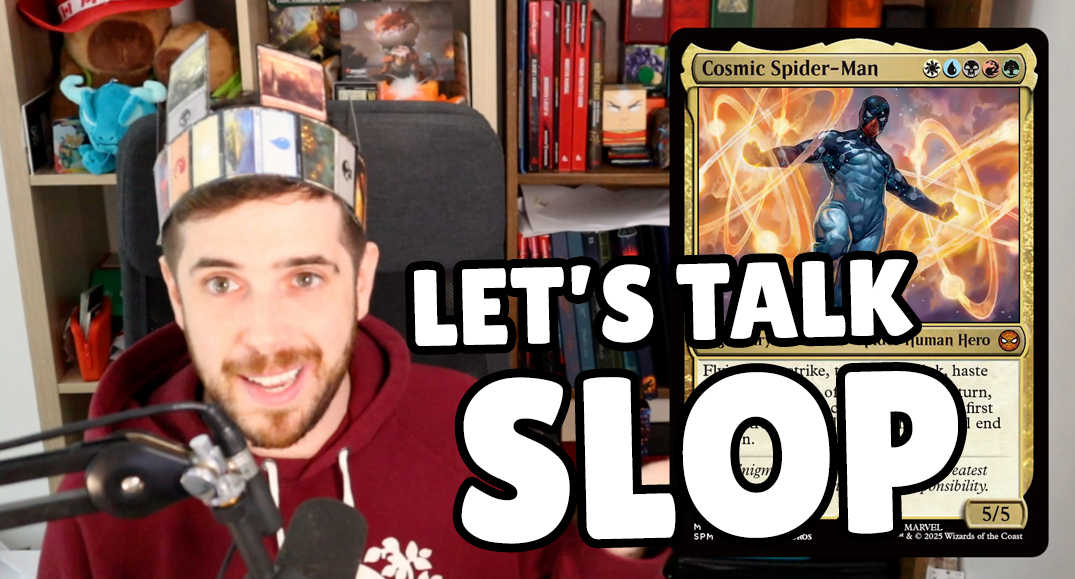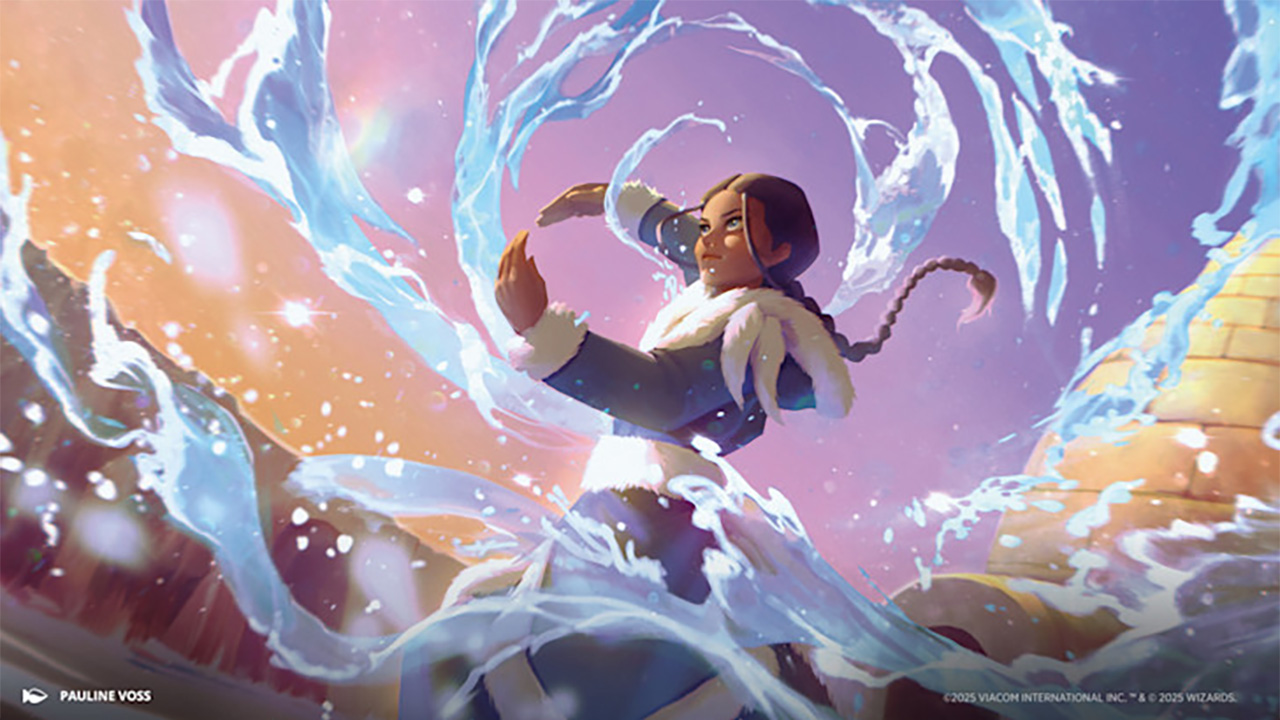Understanding the Modern Banned List
The Modern banned list is unique among Magic formats. Typically, a format starts with zero cards banned, and then cards are added to the banned list as they become too broken or too dominant. Modern, on the other hand, was birthed from Extended and started off with a rather lengthy banned list of cards that were either overpowered in Extended or broken during their life in Standard. Considering it's been about five years since Modern became a format, it seems likely at this point that there's an entire generation of Magic players who don't really understand why certain cards are on the banned list.
It's easy to look at Modern—a format where Primeval Titans come down on Turn 3 and Storm decks occasionally kill you on Turn 2—and wonder if a card like Blazing Shoal or the artifact lands are really too powerful for the format. So today, we're going to take a few minutes to talk about the Modern banned list, but instead of focusing on what should be unbanned (although this might come up here and there), our primary goal will be to remember why these cards were banned in the first place.
This conversation is important because during the last banned and restricted announcement, Wizards said that it was considering unbanning cards in the format after Pro Tour Rivals of Ixalan, which has led to some crazy unbanning suggestions. So before we spend the next few months debating the Modern banned list, including what should go on and what should come off, let's take a few minutes to talk about how these cards got in Modern jail to begin with.
Banned in Standard
Artifact Lands





The artifact lands have been banned in Modern since the very first banned list, based primarily on the fact that they were banned way back in Mirrodin Standard. They aren't alone in being punished for their Standard sins: in fact, every potentially Modern-legal card that had been banned in Standard was on the initial Modern banned list as well.
If you've never played with the artifact lands, their power might not be readily apparent. In fact, the might actually look bad, since they are lands that turn your opponent's Ancient Grudge into a double Stone Rain and turn Stony Silence into an upkeep-free, one-sided Stasis. The power of the artifact lands isn't so much the lands themselves but some of the artifact payoffs that are already popular in the Modern format. With Seat of the Synod and friends around, Arcbound Ravager suddenly becomes even more powerful, being able to eat lands along with other artifacts to dump a bunch of counters on an Inkmoth Nexus for the one-shot kill, and Cranial Plating becomes even scarier. If you think about the typical Modern Affinity deck, the lands are some of the only cards that don't power up its artifact synergies, which is one of the things that keeps the deck somewhat fair.

The only major downside of having the artifact lands banned is that having a card like Seat of the Synod or Vault of Whispers in the format might finally make Tezzeret, Agent of Bolas into a real deck, but unbanning the lands would make Affinity so much more powerful that it probably wouldn't really matter anyway. The other sneaky downside of having the artifact lands in the format is that it would make Stony Silence even swingier, to the point where it would push decks to splash for Stony Silence in the sideboard and maybe even mulligan to find a Stony Silence in the Affinity matchup (much like decks mulligan for graveyard hate against Dredge). This would probably make the format less fun in general because instead of games being about what decisions you make or how your build your deck, your games against the most popular deck in the format would only be about how good you were at mulliganing into a game-ending, Turn-2 sideboard card.
Skullclamp
Skullclamp is an easy one: it's banned in every format because Wizards made a mistake. You can read the whole story here, back from when Wizards initially banned the equipment in Standard, but the short version is that Skullclamp was changed from giving the equipped creature +1/+2 to +1/-1 late in development and slipped through the cracks. If you're one of the people who wonders whether Skullclamp would still be broken today, nearly 15 years after it was originally printed, the answer is pretty clearly yes. When Randy Buehler ran a Gauntlet of Greatness for No-Banned-List Modern, unsurprisingly, it was two Skullclamp decks that met in the finals. Drawing two cards for a single mana is already pretty broken, even if you have to destroy a random one-drop to do it. Could you imagine if Lingering Souls was not just make four 1/1s but also pay four, draw eight cards? That's the world we'd live in if Skullclamp were legal in Modern, and that's not even considering decks like Elves, which is probably the most competitive home for the equipment.
Jace, the Mind Sculptor / Stoneforge Mystic


Jace, the Mind Sculptor and Stoneforge Mystic are forever entwined thanks to their dominance in Standard in the Caw-Blade deck (widely held to be one of the best Standard decks of all time). Caw-Blade was so dominant that both Jace, the Mind Sculptor and Stoneforge Mystic were banned in Standard, which was a huge deal at the time, when Standard bannings happened about once every decade rather than once every three months. As such, both cards started off on the initial Modern banned list under the "they were banned in Standard" clause.
Perhaps the most interesting part of both of these cards is that they are usually ranked among the top three cards most likely to come off the Modern banned list, and while our goal today is to focus on why the cards on the Modern banned list were put there in the first place, let's take a minute to break one of our own rules and discuss the idea of Stoneforge Mystic and Jace, the Mind Sculptor becoming legal in Modern.
Let's start with Stoneforge Mystic. The main argument against unbanning Stoneforge Mystic is the existence of Batterskull. It is true that the opportunity cost of running the Stoneforge / Batterskull "combo" is pretty low, and if Stoneforge Mystic were legal, we'd probably see it slot into all kinds of decks, ranging from aggro Zoo builds to hardcore control. While I'm not sure how scared I am of a Turn 3 Batterskull in a format where you die to Storm on Turn 3 or get Primeval Titaned on Turn 4, probably the biggest risk is that having a big uptick in play from Batterskull would push aggressive creature decks (which really struggle with Batterskull) out of the format and potentially throw the currently diverse format out of whack. As such, I'm really on the fence about unbanning Stoneforge Mystic, at least without without also banning Batterskull. Without Batterskull in the format, Stoneforge Mystic would be 100% safe to unban. The plan of tutoring up Swords and Bonesplinters feels too slow for Modern.


On the other hand, the upside of unbanning Stoneforge Mystic is that it might actually increase the diversity of the format by enabling some Puresteel Paladin jank or making Thopter Sword into a more competitive deck. All in all, I'm not against giving Stoneforge Mystic a shot in the format, but I'm not convinced the experiment will end well.

A year ago, I was fully on board the unban Jace, the Mind Sculptor train. Infect was the best deck in the format, with Affinity and Burn also being tier one, and the very idea that you could live long enough to tap out for a Jace, the Mind Sculptor on Turn 4 seemed insane. Over the past year, Modern has changed quite a bit, both because of the Gitaxian Probe banning and because of the printing of Fatal Push, and while the format is still fast, consistently dying on Turn 2 or 3 is less common than it was a year ago. Thanks to these format changes, I'm now in the middle with Jace, the Mind Sculptor. On one hand, the four-mana planeswalker still seems pretty bad in a lot of matchups, where it's still unlikely you'll find time to tap out for it without dying. On the other hand, Jeskai and UW Control aren't that far away from being top-tier decks, and it's possible that unleashing Jace, the Mind Sculptor would lead to the return of hardcore tap-out control, which I would enjoy but many people dislike. Maybe the problem isn't tapping out for Jace, the Mind Sculptor on Turn 4 but the deck that figures out the way to pick apart all of your resources, empty your hand with Thoughtseize and Mana Leaks, and then stick a Jace, the Mind Sculptor on Turn 8 to fateseal you into oblivion.
Maybe the biggest reason to keep Jace, the Mind Sculptor banned is because it feels really, really bad to lose to Jace, the Mind Sculptor's fateseal ability. It's the same feeling you get when your opponent has all of their Lantern Control pieces locked in. You know it's not really a hard lock, so you can't just scoop the game, but you also know that your odds of winning are extremely low. Plus, it takes a bunch of turns of sitting through the "please just kill me" purgatory before your opponent actually wins the game with Jace, the Mind Sculptor. So, maybe the feel-badness of losing to Jace, the Mind Sculptor is reason enough to keep the planeswalker banned. Overall, much like Stoneforge Mystic, I'm open to giving Jace, the Mind Sculptor a trial period in Modern, with everyone knowing going into the experiment that a re-banning might be necessary if things go poorly.
Turn 3 Combos
Glimpse of Nature
One of Wizards' initial rules for the Modern format was that it didn't want combo decks that consistently won the game before Turn 4, which is the primary reason why Glimpse of Nature was on the original Modern banned list. In Elves specifically, Glimpse of Nature made it pretty easy to play through your entire deck on Turn 2 or 3. You simply resolve a Glimpse of Nature and start playing Elves, all of which work like hasty Llanowar Elves as long as you have a Heritage Druid on the battlefield. Eventually, you find some copies of Nettle Sentinel, which allow you to go infinite in mana, and more copies of Glimpse of Nature, so each Elf you cast is drawing you two, then three, and then four cards instead of just one. Eventually, you win the game. Originally, the finisher was Predator Dragon, but I imagine today it would be some combination of Craterhoof Behemoth and Emrakul, the Aeons Torn coming down on Turn 2 or 3.


Maybe the most interesting aspect of Glimpse of Nature is how it shows that just one mana can make a huge difference in the power of a card. Glimpse of Nature is broken and (in my opinion) rightly banned in Modern, while Beck // Call, which is essentially an upgraded version of the effect for just one more mana, goes unplayed in the format.
Hypergenesis
Hypergenesis is another member of the original Modern banned list, thanks mostly to its power with cascade cards. When you think about how Hypergenesis works, it's basically just a straight-up better version of Restore Balance or Living End, both of which are somewhere between playable and very good in Modern in their own right. The main thing that keeps decks like Living End and Restore Balance in check is that they come with a significant downside. Living End is incredibly powerful but comes with the drawback of scooping to graveyard hate. Restore Balance is strong but comes with a high deck-building cost to break the symmetry and make sure it's hurting your opponent more than it's hurting you. Hypergenesis works the same way but doesn't come with any major drawback or deck-building cost. You simply play a bunch of cascade cards, stuff your deck full of Emrakul, the Aeons Torn and Griselbrands, and essentially win the game when you resolve Hypergenesis.
Blazing Shoal
Blazing Shoal might be the card that people misunderstand most often on the Modern banned list. There's an entire cycle of Shoals, and all but the red member of the cycle are legal in Modern without causing problems (or even being playable, for the most part). Blazing Shoal can blame its banishment on Sam Black, who came pretty close to winning the very first Modern Pro Tour with an innovative Mono-Blue Infect deck that killed on Turn 2 or 3 pretty consistently thanks to Blazing Shoal.



The basic combo is using Blazing Shoal to exile a Dragonstorm or Progenitus, which is exactly enough infect damage to kill the opponent with Inkmoth Nexus or a Blighted Agent. This would occasionally happen on Turn 2 and fairly regularly on Turn 3 thanks to Muddle the Mixture tutoring up Blazing Shoal and Summoner's Pact tutoring up Progenitus. Remember the Infect deck that dominated Modern about a year ago, before Gitaxian Probe was banned and Fatal Push was printed? Mono-Blue Infect did the same thing, but instead of needing to cast multiple pump spells that cost real mana, it would do it all by casting a single Blazing Shoal for free.
Dark Depths

Dark Depths was part of the initial Modern banned list mostly because of its power in the Extended format (which, in some ways, was the forerunner of Modern, as a format between Standard and Legacy). At first glance, the land doesn't look all that powerful because it's extremely slow—taking 10 turns of spending three mana to get an indestructible 20/20 flier. The problem is no one ever played Dark Depths fairly. The initial combo was to play Dark Depths on Turn 1, play Urborg, Tomb of Yawgmoth into Vampire Hexmage on Turn 2, and then simply use Vampire Hexmage to removal all of the counters off of your Dark Depths at the end of your opponent's turn, get a 20/20 Marit Lage, and kill your opponent on Turn 3, as long as they didn't have a Path to Exile.




The scary thing about Dark Depths is that it would be even better in Modern today than when it was banned. For one thing, people are leaning more and more on Fatal Push and less on Path to Exile, which makes it even less likely than an opponent can deal with a 20/20 indestructible creature, but more importantly, we have even more combo pieces. For example, with a Solemnity on the battlefield, you simply play a Dark Depths and get a 20/20. If your opponent can somehow deal with it, you can always play another copy of Dark Depths or Life from the Loam back the original and do it all over again. And this doesn't even consider the rules change to Blood Moon that makes it into a Dark Depths combo piece, or the printing of Thespian's Stage (which is the primary Dark Depths combo in Legacy). A 20/20 indestructible is a big enough payoff that a lot of decks in Modern would try to incorporate some type of Dark Depths kill if it were legal in the format. Next time you get frustrated by a Turn 2 Thought-Knot Seer, take a minute to be thankful that you're not staring down a 20/20 indestructible, uncounterable Marit Lage token.
Golgari Grave-Troll

Golgari Grave-Troll holds the distinction of being the only card to be banned twice in Modern. It started off on the original Modern banned list, mostly because Dredge is one of the ultimate "mistake" mechanics that many people (including Wizards) would rather forget. Then it was given a surprising parole by Wizards, only to fall back in with the same crowd (along with some new offenders, like Cathartic Reunion), and it wasn't long before Golgari Grave-Troll enabled 10+ power on Turn 2 one too many times and found itself on its way back to Modern prison, where it's likely looking at a life sentence.
Unfortunately for Golgari Grave-Troll, it's not so much that the card itself is overpowered; it's that a critical mass of cards with the Dredge mechanic are overpowered. When Golgari Grave-Troll is on the loose, it gives Dredge decks one more good Dredge card, which is just enough to push the deck from fringe to tier one in Modern, and very few people have fun when Dredge is near the top of the format.
Fast Mana
Rite of Flame / Seething Song

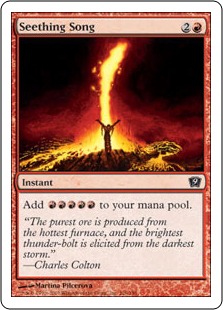
While banned at different times, Rite of Flame and Seething Song were banned for the same reason: Storm decks were too powerful. While the lack of consistency is a bit maddening (*cough* Eldrazi Temple *cough*), over the years, Wizards seems to have taken a view of Modern in which cards that add one additional mana are safe but cards that add two extra mana should be banned, and over the years, the banned list of the format has come to reflect this ideal fairly well. Since we'll talk about Storm a couple of times over the course of this article, you might be wondering if it really deserved all of the bannings it received over the years, and the answer is pretty clearly yes.

Remember: Storm is still a top tier deck today, even after being targeted by three rounds of bannings. In fact, if you look back at the original Storm list from Pro Tour Philadelphia in 2011, a full 16 of its 38 non-land main-deck cards have been banned (and this doesn't even count Seething Song, which wasn't even good enough to make it into the original build and came along later after Rite of Flame was banned).
The biggest problem with Storm (and the reason why cards that add two or more mana should remain banned in Modern, even though I'd love to play Rite of Flame in Free-Win Red) is that the mechanic itself ranks alongside Dredge as the biggest mistake mechanic in Magic's history (in fact, it's such a mistake that Maro's "Storm Scale," which ranks how likely a mechanic is to return in a future set, is named after it). It's simply not the way Wizards (or most players, for that matter) wants Magic to be played in 2017, especially in Modern. With each passing year, as new players joined the game through Standard formats that were about creatures rather than degenerate spells and combos, this has become more and more true. Because of this, it's probably more likely that we see yet another banning targeted at Storm rather than one of its pieces coming off of the banned list.
Summer Bloom
While it took a while for Modern players to figure it out, Summer Bloom eventually ended up meeting its end thanks to breaking the "adds two or more mana" rule. Actually, it didn't just break the rule but absolutely shattered it. The basic idea of Summer Bloom was to play it after putting an Amulet of Vigor on the battlefield and then play some Ravnica bounce land like Simic Growth Chamber. You then spend all four of your land drops playing and tapping the Simic Growth Chamber and then returning it to your hand, with the end result being that Summer Bloom is a ritual that costs two mana and adds six mana to your mana pool (exactly enough to play a Primeval Titan, which is where things get even sillier, since the lands you tutor up with Primeval Titan untap as well, and you pretty much just win the game on the spot, sometimes on Turn 2). Once it became clear that Summer Bloom was the green Dark Ritual, Wizards quickly added it to the banned list, where it will likely remain for eternity.
Cloudpost
Cloudpost joined Blazing Shoal on the post-Pro Tour Philadelphia (the first Modern Pro Tour) banned list after smashing its way thought the tournament as a sort of super-Tron. If you think Tron—the current big-mana deck in Modern—is annoying to play against, Cloudpost decks were even worse, basically being Tron decks that also occasionally hard cast Emrakul, the Aeons Torn on Turn 5 thanks to the absurd amount of mana you can make by copying Cloudpost with Vesuva. One of the sneaky aspects of the deck was how good it was against aggro, since against a deck like Burn, you could just use all of your land tutors to find Glimmerpost to gain a bunch of life while still powering up any Cloudposts you had on the battlefield. I've heard some people say that Cloudpost isn't really that good or even that Tron is better, but after absolutely crushing Eldrazi Winter Eldrazi with 12 Post, it's hard for me to believe that we want lands that commonly tap for three or four mana running around in the Modern format.
Green Sun's Zenith


Green Sun's Zenith is one of the stranger cards on the Modern banned list, mostly because, at least to some extent, it finds itself in Modern jail not because it's too powerful on its own but because of the weirdness of a certain land from Future Sight: Dryad Arbor. While there's not doubt that Green Sun's Zenith is a powerful card and would see play in Modern to add consistency to toolbox green decks with cards like Gaddock Teeg, Knight of the Reliquary, and Primeval Titan, in most situations, it isn't that much more powerful than Chord of Calling (which is instant speed and hits creatures of any color) or Collected Company (instant speed and hits two creatures, instead of just one). The problem is Green Sun's Zenith was very, very good at doing one specific thing: being a one-mana Rampant Growth by tutoring out Dryad Arbor (which is technically a zero-mana green creature).
Now, you're probably thinking, what's the big deal? A Turn 1 Dryad Arbor isn't really any different from a Turn 1 Llanowar Elves or Elvish Mystic, and while this is true on Turn 1, the big difference is that Green Sun's Zenith is both a Llanowar Elves on Turn 1 and a Primeval Titan on Turn 5 or 6 (depending on how much you ramp). Turn 1 mana dorks are super powerful but held in check by the fact that they get worse and worse as the game goes along (drawing a Elvish Mystic off the top during the mid- to late game is usually horrible). Green Sun's Zenith flips this idea on its head by being a Turn 1 mana dork that is just as good (and perhaps even better) on Turns 3, 5, and 10. If Dryad Arbor were to leave the format, there might be an argument for giving Green Sun's Zenith another shot, especially considering all of the other cards fighting for the same slot, but until that happens, it's simply too good for the format thanks to its flexibility.
Chrome Mox

Chrome Mox is one of the stranger cards on the Modern banned list. It was part of the original Modern banned list without any in-depth explanation and remains on the banned list, even though it doesn't break the "adds two or more mana" rule. While it would be easy to say that Wizards just doesn't want fast mana to be a part of Modern at all, this flies in the face of other +1 mana cards like Mox Opal, Simian Spirit Guide, and various rituals (Pyretic Ritual, Desperate Ritual) that are still in Modern.
While going from one mana to two mana on Turn 1 is powerful, using Chrome Mox comes at a pretty big cost (exiling a card from your hand), which keeps it from being played in some decks all by itself. The biggest risk is that the fast mana it gives would power up combos too much, and while it's probably safest to have Chrome Mox banned, it does seem strange to see it on the banned list after watching Affinity play Mox Opal on Turn 1 and dump literally their entire hand onto the battlefield.
Eye of Ugin
On its face, the Eye of Ugin banning makes sense for a bunch of different reasons. Eldrazi Winter essentially ruined the Modern format for several months before the land was banned. Eye of Ugin clearly breaks the "adds two or more mana" rule (sometimes adding much more than two mana if you have a bunch of colorless Eldrazi in hand). Plus, Eye of Ugin gave Tron decks an inevitable late game, which would likely push them over the top at the moment, considering Tron is still near the top of the format even without Eye of Ugin. As such, the reasons why Eye of Ugin is on the banned list are pretty simple and clear.


On the other hand, seeing Eye of Ugin on the banned list, in part, because it breaks the "adds two or more mana" rule begs the question of why Eldrazi Temple is still allowed in the format. While not allowing cards that produce two or more mana in the format seems like a good and reasonable rule, the rule isn't really worth much of anything unless it's enforced consistently. There's actually still a debate over whether Eye of Ugin or Eldrazi Temple is the more powerful of the Eldrazi Sol-lands, and while the answer is very like Eldrazi Temple if we only look at Eldrazi decks, the fact that Eye of Ugin is so good in Tron as well might make it more powerful in the Modern format as a whole.
Basically, Eye of Ugin is banned mostly because it was part of the most dominant deck Modern had seen in years in Colorless Eldrazi, and while this banning makes sense, it also makes you wonder why its partner in crime Eldrazi Temple is still on the loose rather than being locked up alongside Eye of Ugin in Modern jail.
Oddballs
Umezawa's Jitte

While Umezawa's Jitte was never actually banned in Standard, it dominated its Standard format to such a great extent that decks with no interest in playing the equipment would occasionally do so just to legend rule their opponent's copies (back when the legend rule made it so if two of the same legendary permanent were on the battlefield, both immediately went to the graveyard). The power of Umezawa's Jitte is that it destroys creature decks, and while it might be a bit slow for Modern, it would still push certain decks (like Elves and perhaps even some Collected Company builds) out of the format. If you've never played with Umezawa's Jitte, apart from having a ton of different abilities, the main reason it's so powerful if that you get counters whenever it deals combat damage, not just combat damage to the opponent. This puts players in a no-win situation where if you chump the creature wearing Umezawa's Jitte, your creature dies and your opponent get Jitte counters, and if you don't chump, they get counters and kill your creature anyway. While the "it's slow and bad in a lot of matchups" argument might be reason enough to consider releasing [[Umezawa's Jitte] from Modern jail, it would at the very least show up in sideboards to punish people for playing small creatures. And remember: this is Modern, where Punishing Fire is banned specifically because it hurts little-creature decks too much, and Umezawa's Jitte is twice as punishing, no matter what the cards' names suggest. As long as Punishing Fire is banned, it's hard to imagine Umezawa's Jitte coming off the banned list either.
Ponder / Preordain


While the easiest explanation for Ponder and Preordain being on the Modern banned list is that they made Storm too good, and while it's true that Storm was near the top of the format when they were unbanned, in no small part thanks to the power of the one-mana cantrips, the better explanation is that they are simply too good and were keeping Modern from developing its own identity as a format. If you think about Legacy, the card that defines the format is Brainstorm—another one-mana cantrip that shows up in a ton of different decks and allows players to see most of their deck over the course of the game in conjunction with fetch lands. Back in the early years of Modern, the format was in danger of being viewed as a worse version of Legacy, where everyone simply cantripped into their combo as fast as possible but with no Force of Will to keep things in line. Getting rid of both Ponder and Preordain allowed Modern to develop into the incredibly diverse format it is today, with 15 or even 20 decks regularly showing up in the Top 32 of tournaments. If the one-mana cantrips were around, combo would be even more consistent and, because of this consistency, probably a bit faster as well, which would push decks toward playing or splashing blue, just for the power of Preordain and Ponder, and the diversity we see today would be greatly diminished.
Punishing Fire

Punishing Fire is among the stranger cards on the Modern banned list. The original justification for the banning back in 2011 was that two damage for three mana (thanks to Grove of the Burnwillows forcing the opponent to gain life) was a bit too good, especially against decks featuring small creatures, which Punishing Fire was keeping from the format. While it is true that the instant is punishing to decks like Merfolk and that the combination of Punishing Fire and Grove of the Burnwillows is a strong engine if the game goes extremely long, if you look back at the Modern format from Worlds 2011 (the tournament cited in the banned announcement), it looked a lot different than Modern does today. In fact, the 2011 Modern format was incredibly grindy, featuring a ton of Jund, big Zoo, Affinity, and control decks without any combo decks in sight. If you look at the top decks in the format today, they are either playing big creatures like Eldrazi, Death's Shadow, and Gurmag Angler or combo-killing with Storm, Scapeshift, or Burn spells. Plus, nearly every deck is playing Surgical Extraction or some form of graveyard hate that can stop the Punishing Fire engine. This isn't to say that Punishing Fire would be safe in our current Modern format, just that I'm not sure if the reasons why Punishing Fire was originally banned still apply today.
Bloodbraid Elf / Deathrite Shaman


If you've only started playing or following Modern recently, you might not realize that there was a very long period of time when Jund was the best deck in the format. While the archetype still exists today, it normally floats in the tier 1.5 range, in part because of the bannings of Bloodbraid Elf and Deathrite Shaman.

The story behind the banning of these two Jund cards is actually a bit confusing. Jund, formerly the best deck in Modern, had dropped off a bit. Then, in Return to Ravnica, Deathrite Shaman was unceremoniously spoiled in the big spoiler dump on the last day of preview season. Next thing you know, Jund was absolutely dominating Pro Tour Return to Ravnica thanks to the one-drop planeswalker. While making up 31% of the meta might not sound that crazy (since this happens fairly often in Standard), having one deck make up 31% of the Modern meta is shocking, considering the most played deck in the format often hovers around 10%. Seeing these results, Wizards decided that something needed to be done about Jund, but instead of banning Deathrite Shaman, they threw its partner in crime Bloodbraid Elf into jail instead.
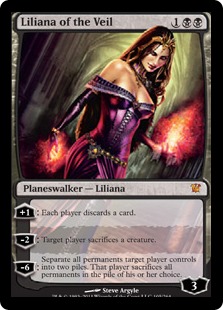
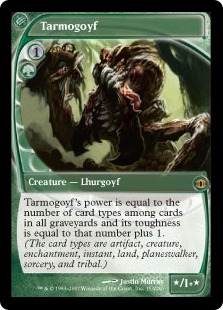

Of course, Jund specifically (and Deathrite Shaman in general) was still too good, so a little while later, Wizards banned the one-drop as well, which pushed Jund down from being the best deck in Modern to being just another good deck but also leaving us with one of the great "what if" questions of the Modern format. What if Wizards had just banned Deathrite Shaman in the first place? Was Bloodbraid Elf really guilty, or was she unjustly found guilty thanks to some of the unsavory company she kept? Because of this, Bloodbraid Elf often comes up when people debate unbanning cards in Modern. While there's no doubt that Bloodbraid Elf is powerful, as a hasty threat that comes along with a free Liliana of the Veil, Thoughtseize, or Tarmogoyf, it's just another grindy two-for-one in a deck that's overflowing with grindy two-for-ones. It's possible that it's only a matter of time before the Elf is vindicated. Perhaps some new DNA evidence will prove once and for all that she is innocent, releasing her to cascade her way back into Modern and bring Jund back to the top of the format.
Too Free
Gitaxian Probe

Gitaxian Probe doesn't look like the kind of card you'd expect to find on a banned list, essentially just being a free Peek at your opponent's hand that also lets you draw a fresh card, but it just goes to show how dangerous free effects can be. It doesn't really matter how much a card does; when it doesn't cost you mana or an actual card, it's likely someone will find a way to abuse it (see: Street Wraith, which probably should be banned on the principle that it violates the spirit of the "free stuff" rule, even though it never actually gets cast as a creature).



While it's easy to miss the power of Gitaxian Probe at first glance, when you really dig into what it did in the Modern format, the reasons for the banning become clearer (as does the overwhelming power of the card). It gives you a look at your opponent's hand, which lets you know if it's safe to go all-in on your combo, a line of play that was especially important to the Infect deck at the top of the format a year ago. It gives you a free card in your graveyard, which was important in powering up Treasure Cruise and Dig Through Time, not to mention the delve cards that remain in the format like Gurmag Angler and Tasigur, the Golden Fang. It gives you a free "spell" trigger for cards like Pyromancer Ascension and Young Pyromancer, and it even loses you life, which is strangely a benefit rather than a drawback in a world ruled by Death's Shadow. All of these little, seemingly insignificant effects added up to Gitaxian Probe being one of the most powerful cards in the Modern format, which eventually led to its downfall.
Dig Through Time / Treasure Cruise

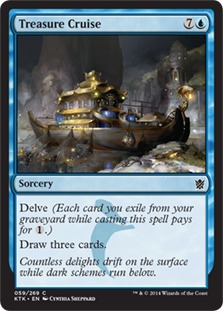
While Dig Through Time and Treasure Cruise aren't actually free, they are way too close to free to be fair in Modern. Wizards has been pretty forthcoming about the fact that most of their testing is focused on Standard, and the delve cards from Khans of Tarkir block are a great example of how cards can be fair in Standard but broken in older formats, as counterintuitive as this seems. In Standard, even Khans Standard with fetch lands, it took some effort to make Treasure Cruise and Dig Through Time cheap. In Modern, the combination of fetch lands, cheap graveyard fillers like Thought Scour and Gitaxian Probe, and efficient burn spells like Lightning Bolt made it so Treasure Cruise played a lot like Ancestral Recall and Dig Through Time like Demonic Tutor.
The end result was a period of time where UR Delver was by far the best deck in Modern, thanks to the power of Treasure Cruise, which led to both of the blue delve spells being banned just a few months after they were printed. While this may have been partly because a Modern Pro Tour was around the corner (Birthing Pod, which we'll talk about in a minute, was banned at the same time), there were few complaints from the community because unlike other Pro Tour-related bannings, it was clear to pretty much everyone involved that the cards were simply too efficient for Modern.
Dread Return

Dread Return is actually similar to Golgari Grave-Troll in the sense that the original reason it was banned was to power down Dredge, which doesn't really have a place as a tier deck in the Modern format. More importantly, even discounting Dredge specifically, Dread Return is just a bit too free to be set loose in Modern. One of the ways that Wizards makes Modern feel different than Legacy is the lack of powerful free spells. In Legacy, even if your opponent is tapped out, you always have to worry that your key spell will be Force of Willed or Misdirectioned. In Modern, the free spells are much tamer. While we see cards like Disrupting Shoal show up occasionally, for the most part, if you want to do something powerful, you are going to need to spend mana on it. Dread Return is easy enough to cast without any real mana that it breaks the "no powerful free spells" rule, which should keep it on the sidelines in Modern for the foreseeable future.
Mental Misstep

Our last free spell was actually the first of the free spells banned in Modern: Mental Misstep. Mental Misstep was banned in the initial Modern banned announcement, based mostly on how it played in Legacy, where it essentially pushed one-mana plays out of the format and made most decks 56 cards, since everyone had to run Mental Misstep, not so much because they wanted Mental Misstep in their deck but because they needed to be able to counter their opponent's Mental Missteps. Having a card that you essentially must put in your deck, no matter what deck your are playing, is a pretty unhealthy thing for a format, which means Modern is likely better off with Mental Misstep on the banned list.
Too Slow and Boring
Second Sunrise
While Second Sunrise probably would have been banned anyway, it was Brian Kibler who sealed the card's fate when he infamously "put an F6 (the Magic Online key for "pass until end of turn") into play" during the Top 8 of Grand Prix San Diego back in 2013. That moment was emblematic of everything that was wrong about Eggs combo. While the deck wasn't that good (it scoops to a lot of sideboard cards), it's also nearly impossible to beat if you don't happen to have the right sideboard cards. Plus, it's incredibly boring to play against (the combo occasionally involved playing through your entire deck before eventually looping a Pyrite Spellbomb to win the game) and even more boring to watch. After sneaking out a win at Pro Tour Return to Ravnica by catching the field by surprise, Eggs became a "real" deck in Modern, which was a miserable experience for everyone involved except for the person playing Eggs. It was the combination of 20-minute combo turns, mind-numbing boredom, and Kibler's "F6" that finally put the Second Sunrise to rest. While it's probably true that Eggs wouldn't be too powerful for Modern at the moment, being too powerful was never really the problem—the deck simply was too unfun and slow for Modern. Especially with Wizards' focus on coverage and the return of the Modern Pro Tour, it seems exceedingly unlikely Second Sunrise will rise again in the format anytime soon.
Sensei's Divining Top

Sensei's Divining Top is another original member of the Modern banned list, but instead of power-level concerns (although it might be too good now, thanks to the miracle mechanic and Counterbalance, giving Modern access to most of the pieces of the now-banned Legacy Miracles deck), the main reason the artifact was banned is because it slows the game down to a halt. While it's possible to play quickly with Sensei's Divining Top, it's more common that tournaments devolve into people playing with Sensei's Divining Top for the first time and turns going something like this: end of your turn, activate Top, spend 45 seconds rearranging the top of my library, pause to think for 15 seconds, crack a fetch land, use the mana to activate Top, spend 45 more seconds rearranging the top of my library, untap, draw for my turn, activate Top, spend 45 seconds rearranging the top three cards of my library, rinse and repeat. The end result is usually the match going to time, assuming the Top player's opponent doesn't flip the table first. And I say this as someone who absolutely loves playing with Sensei's Divining Top. It's one of my all-time favorite cards to activate, since it supports the "endlessly durdle and draw extra cards" technique perfectly.
There's a Modern Pro Tour Coming!!!
Splinter Twin
I'm not going to spend too long talking about why Splinter Twin was banned, mostly because I wrote an entire article discussing the topic (you can read it here). Basically, from my perspective, any explanation for the banning of Splinter Twin other than "Wizards wanted to shake up the Modern format for the sake of the Pro Tour and perhaps to make sure that the Oath of the Gatewatch Eldrazi got a chance to shine on the Pro Tour stage" rings hollow. Splinter Twin was a good deck, at some point even the best deck in Modern, but if you look at the numbers, they weren't any higher than decks like Affinity, peak Death's Shadow, or any number of other top-tier decks in the Modern format.
Now, you're probably thinking that the card should probably be unbanned, considering the initial reasons for banning Splinter Twin are suspect at best, but I'm not sure this is true. While I do think that it would probably be safe to unban Splinter Twin, Modern is in a very diverse and healthy place at the moment, and I'm not sure that it's worth risking this balance just to right the wrong that was done to Splinter Twin years ago. In some strange way, it was both wrong to ban Splinter Twin at the time but also wrong to unban it now, as crazy as it sounds.
Birthing Pod
Birthing Pod looks a bit like Splinter Twin, being banned to shake up a Modern Pro Tour, and while this is true on its face, unlike Splinter Twin, there are also a lot of good reasons why Birthing Pod is banned. For the last several years, Wizards' focus has been on printing power creatures, and every time a good creature is printed, Birthing Pod gets a little bit better. It wasn't that long ago that most combo decks were built around spells (think Storm and Ad Nauseam), but now, many combos are creature-based, like Melira, Sylvok Outcast and Kitchen Finks or Devoted Druid and Vizier of Remedies. Because of this, Birthing Pod is a fairly unsafe card to have floating around in Modern. Even if it wasn't objectively too good when it was banned (although it was very good), it was getting better set by set and would have almost certainly become too good eventually, as Wizards continued to print great creatures to tutor up. With this in mind, cutting it out of the format entirely was probably the correct move, rather than waiting until Birthing Pod got even more out of hand (and until even more people bought into the deck), which would have made the inevitable banning even more painful in the long run. So, while an impending Modern Pro Tour likely hastened Birthing Pod's demise, the end was coming sooner or later, so it's unfair to blame the banning on the Pro Tour in its entirety.
Conclusion
As you can see, while there are a lot of different cards banned in Modern, most fall into a few simple categories, with producing fast mana, enabling Turn 3 combos, and being free (or at least way too cheap) being the most common. Two things stand out if you look over the list of currently banned cards. First, most of the bannings seem to be correct. Out of the 35 cards on the list, you might be able to make a strong argument that four or five should be considered for unbanning, but for the rest, it's hard for me to even justify having a conversation about their unbanning. Second, looking over the categories of banned cards, there are still some weird inconsistencies in the format. It's hard to see why Eldrazi Temple is safe if all of the other cards that make two mana are banned, or why Chrome Mox deserves a life sentence while Mox Opal is running free in Affinity.
Now that we've discussed why the cards on the Modern banned list are on the list, it's time for the fun part. As I mentioned in the intro, Wizards suggested that it is looking at possibly unbanning something in February, after the next Modern Pro Tour. So, keeping the reasons for all of these bannings in mind, what card(s) do you want to see come off the Modern banned list? Are any of the cards currently on the list safe, or would they break Modern? How good would former Standard all-stars like Jace, the Mind Sculptor or Stoneforge Mystic be in the format? Should we unleash any of the currently banned fast-mana cards, or should Wizards look into banning some of the fast mana still in the format for the sake of consistency? Let me know in the comments!
As always, leave your thoughts, ideas, opinions, and suggestions, and you can reach me on Twitter @SaffronOlive or at SaffronOlive@MTGGoldfish.com.


